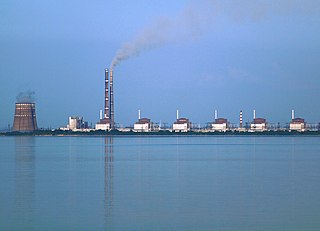| Ninghai Power Station | |
|---|---|
 | |
| Country |
|
| Coordinates | 29°28′57″N121°30′34″E / 29.4825°N 121.5094°E |
| Owner(s) | |
| Power generation | |
| Nameplate capacity |
|
Ninghai Power Station is a large coal-fired power station in China. [1] [2] [3]
| Ninghai Power Station | |
|---|---|
 | |
| Country |
|
| Coordinates | 29°28′57″N121°30′34″E / 29.4825°N 121.5094°E |
| Owner(s) | |
| Power generation | |
| Nameplate capacity |
|
Ninghai Power Station is a large coal-fired power station in China. [1] [2] [3]

Electricity generation is the process of generating electric power from sources of primary energy. For utilities in the electric power industry, it is the stage prior to its delivery to end users or its storage.

Duke Energy Corporation is an American electric power and natural gas holding company headquartered in Charlotte, North Carolina.

The Castle Peak Power Station is the largest coal-fired power station in Hong Kong. It is situated in Tap Shek Kok, Tuen Mun District, on the north shore of Urmston Road. It was named after the nearby Castle Peak. The station consists of four 350 MW and four 677 MW generating units, with auxiliary facilities.

A coal-fired power station or coal power plant is a thermal power station which burns coal to generate electricity. Worldwide there are over 2,400 coal-fired power stations, totaling over 2,000 gigawatts capacity. They generate about a third of the world's electricity, but cause many illnesses and the most early deaths, mainly from air pollution.

China is the largest producer and consumer of coal and the largest user of coal-generated electricity in the world. The share of coal in the Chinese energy mix declined to 55% in 2021 according to the US Energy Information Agency.

The Lambton Generating Station was a coal-fuelled power plant located on the St. Clair River near Corunna, Ontario, delivering up to 950 MW of power to the grid. It is owned by Ontario Power Generation.

The Boardman Coal Plant was a coal-fired power plant located in Boardman, Oregon. The facility had a nameplate capacity of 550 megawatts (MWs) and is owned by Portland General Electric. In 2010, the plant was the only remaining coal powered plant in Oregon and received much attention from regional media due to its being the largest single source of greenhouse gas emissions in the state with environmental groups such as the Sierra Club calling for its closing.
The Tuoketuo Power Station is the largest coal-fired power station in the world. The plant is located in Togtoh County, Hohhot, Inner Mongolia, China. The plant is estimated to have been one of the ten most carbon emitting coal-fired power plants in the world in 2018, at 29.46 million tons of carbon dioxide, and relative emissions are estimated at 1.45 kg per kWh. The plant was commissioned in November 1995 by the Tuoketuo Power Company, which currently owns and operates the power station.

Energy in Ukraine is mainly from gas and coal, followed by nuclear and oil. The coal industry has been disrupted by conflict. Most gas and oil is imported, but since 2015 energy policy has prioritised diversifying energy supply.

Energy consumption per person in Turkey is similar to the world average, and over 85 per cent is from fossil fuels. From 1990 to 2017 annual primary energy supply tripled, but then remained constant to 2019. In 2019, Turkey's primary energy supply included around 30 per cent oil, 30 per cent coal, and 25 per cent gas. These fossil fuels contribute to Turkey's air pollution and its above average greenhouse gas emissions. Turkey mines its own lignite but imports three-quarters of its energy, including half the coal and almost all the oil and gas it requires, and its energy policy prioritises reducing imports.
Emba Hunutlu power station is a 1320 MW coal fired power station in Turkey in Adana Province. As of 2022 it is the largest Chinese foreign direct investment in the country. Despite opposition from many environmental organisations the plant was started up in 2022 and burns Russian coal as it is cheaper than other coal. The plant is less than 2 km from another coal-fired power station, İsken Sugözü.
Afşin-Elbistan C was a planned 1800-MW coal-fired power station which was proposed to be built in Turkey by the state-owned mining company Maden Holding. Estimated to cost over 17 billion lira, at planned capacity it would have generated about 3% of the nation's electricity. According to the environmental impact assessment (EIA) the plant would have burned 23 million tonnes of lignite annually, and emit over 61 million tonnes of CO2 each year for 35 years.
İsken Sugözü power station is a 1320 MW operational coal fired power station in Turkey.
Atlas power station or Atlas Enerji İskenderun power station is a 1200-megawatt coal-fired power station in Turkey in İskenderun in Hatay Province, which burns imported and local coal and receives capacity payments. Construction was financed by Garanti Bank, Akbank and Işbank. Its owner, Diller, is on the Global Coal Exit List.
Tufanbeyli power station is a 450 MW coal-fired power station in Turkey in Tufanbeyli, built in the 2010s, which burns lignite mined locally. The plant is 40% owned by Sabancı Holding via Enerjisa Enerji and 40% by E.ON and in 2022 received capacity payments.
Huilai Power Station or is a large coal-fired power station in China.